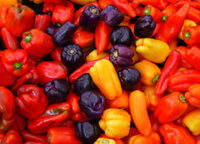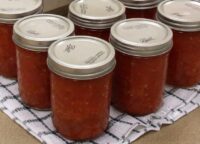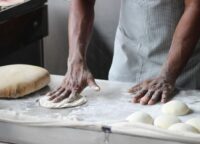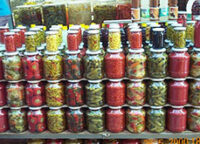- 09, 21, 2015
- Comments Off on Making Pickled Peppers at Home – 9.314
- By admin
Making Pickled Peppers at Home – 9.314
Print this fact sheet by M. Hill and P. Kendall *(8/12) Quick Facts… Use only fresh, blemish-free vegetables and up-to-date, research-based recipes when pickling peppers and pepper blends. Use pure, granulated, non-iodized canning or pickling salt, high grade vinegar of 5 percent acidity, and fresh spices. Process pickled peppers in a boiling water bath for […]
Take a Tour- 09, 21, 2015
- Comments Off on Canning Vegetables – 9.348
- By admin
Canning Vegetables – 9.348
Print this fact sheet by M. Bunning, P. Kendall and E. Shackelton* (2/22) Quick Facts… All instructions in this fact sheet refer to the use of a pressure canner which is designed to reach and maintain 240° F and destroy the botulism toxin. Always use a tested recipe for home canned vegetables and make the […]
Take a Tour- 09, 21, 2015
- Comments Off on Canning Tomatoes and Tomato Products – 9.341
- By admin
Canning Tomatoes and Tomato Products – 9.341
Print this fact sheet A Guide to Canning Tomatoes and Tomato Products By M. Bunning, P. Kendall, and E. Shackelton* (6/23) Quick Facts Home canning is a popular way to preserve tomatoes for later use. Using tested methods and recipes, choice ingredients, and having an awareness of acidity requirements are critical to a safe home-canned […]
Take a Tour- 09, 21, 2015
- Comments Off on Canning Fruits – 9.347
- By admin
Canning Fruits – 9.347
Print this fact sheet by M. Bunning, P. Kendall, and E. Shackleton* Quick Facts… Do not use the open kettle method for canning fruits. Never can in an oven (electric, gas or microwave). Use jar size, processing methods, and time given in reliable, up-to-date canning instructions. Increase boiling water canner processing times at elevations above […]
Take a Tour- 12, 01, 2015
- Comments Off on Herbs: Preserving and Using – 9.335
- By admin
Herbs: Preserving and Using – 9.335
Print this fact sheet by M. Bunning, D. Woo, & P. Kendall* (10/14) Quick Facts… Herbs are used to add flavor, aroma, and color to foods and beverages. Herbs and spices can sometimes replace or reduce salt and sugar in foods. A food dehydrator, oven, microwave oven, or air drying can be used for drying […]
Take a Tour- 09, 21, 2015
- Comments Off on High-Elevation Food Preparation – P41
- By admin
High-Elevation Food Preparation – P41
Print this Fact Sheet A Guide to High-Elevation Food Preparation Newcomers to Colorado or those traveling to the mountains are often surprised when their favorite recipes at sea level fail to produce expected results when made at higher elevations. At heights 3,000 feet above sea level and higher, preparation of food may require changes in […]
Take a Tour- 09, 21, 2015
- Comments Off on Making Pickles – 9.304
- By admin
Making Pickles – 9.304
Print this fact sheet by P. Kendall and C. Schultz * (10/11) Quick Facts… Use only fresh, blemishfree fruits and vegetables and up-to-date, research-based recipes. Use pure, granulated, noniodized canning or pickling salt, high-grade vinegar of 5 percent acidity, and fresh spices. Process pickled products in a boiling water bath for the altitude-adjusted length of […]
Take a Tour- 09, 21, 2015
- Comments Off on Making Jellies – 9.303
- By admin
Making Jellies – 9.303
Print this fact sheet by P. Kendall and M. Lees-Cooley * (10/11) Quick Facts… Jams and jellies can be made from imperfect fruit (not suited for freezing or canning) as long as the fruit is not overripe, spoiled or moldy. Use three-fourths firm-ripe and one-fourth underripe fruit to make jams and jellies without added pectin. […]
Take a Tour- 09, 21, 2015
- Comments Off on Food Preservation Without Sugar or Salt – 9.302
- By admin
Food Preservation Without Sugar or Salt – 9.302
Print this fact sheet by P. Kendall* (10/12) Quick Facts… All fruits can safely be canned or frozen without sugar. Sweet relish and pickle recipes do not adapt as well to sugar-free canning as do plain fruits. Use recipes from reliable sources. Process all pickles by the boiling-water method using timetables adjusted for altitude. Jams […]
Take a Tour- 09, 21, 2015
- Comments Off on Cost of Preserving and Storing Food – 8.704
- By admin
Cost of Preserving and Storing Food – 8.704
Print this fact sheet by P. Kendall and L. Payton 1 (8/08) Quick Facts… Home food preservation saves money for some people. For others it may not save anything. Costs to consider when figuring the economics of food preservation include: produce and ingredients, equipment and supplies, fuel consumption, capital outlays, time and energy, and the […]
Take a Tour











